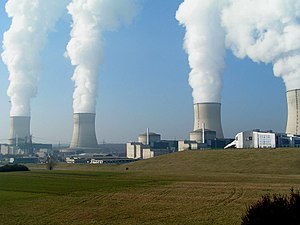Cattenom Nuclear Power Plant
| Cattenom Nuclear Power Plant | |
|---|---|
 Nuclear Power Station Cattenom | |
 | |
| Official name | Centrale Nucléaire de Cattenom |
| Country | France |
| Location | Cattenom, Lorraine |
| Coordinates | 49°24′57″N 6°13′05″E / 49.41583°N 6.21806°E |
| Status | Operational |
| Construction began | 1979 |
| Commission date | November 13, 1986 |
| Operator(s) | EDF |
| Nuclear power station | |
| Reactors | 4 |
| Reactor type | PWR |
| Reactor supplier | Framatome |
| Cooling towers |
|
| Cooling source | |
| Power generation | |
| Units operational | 4 x 1,362 MW |
| Make and model | Alstom |
| Nameplate capacity | 5,448 MW |
| Annual net output | 34,084 GW·h |
| External links | |
| Website | Site c/o EDF |
| Commons | Related media on Commons |
The Cattenom Nuclear Power Station is a nuclear power plant located in Lorraine in the Cattenom commune, France, on the Moselle River between Thionville (10 km upstream) and Trier (80 km downstream). It is close to the city of Luxembourg (35 km) and Metz (40 km).
Description
The site consists of 4 Pressurized Water Reactors that were all built between 1979 and 1991 and have an electric output of 1300 MW each. The plant is a relatively modern and large nuclear power station. In 2006 it produced the third most electricity (34 TWh) of the nuclear plants in France behind Gravelines (38.5 TWh) and Paluel (34.9 TWh).
The plant employs about 1200 regular employees and about 1000 more during outage times.
The station received its ISO 14001 certification in 2005, and should have its ISO 9001 and OHSAS 18001 in 2007.
Cooling
The site uses 4 separate cooling towers which use 890,000,000 m3 (3.1×1010 cu ft) of water from the Moselle annually.[1] Additionally, a water reserve on site, Lake Mirgenbach, was created. In 1985 an artificial lake was also created in the Pierre-Percée valley in the Vosges Mountains. The creation of this lake has led to the flooding of the subterranean portions of Ouvrage Kobenbusch, part of the Maginot Line.
During the 2003 European heat wave the plant was permitted to pipe the waste heat water used for cooling directly into the Moselle river. The heating of the water in these cases is limited to 1.5 degrees Celsius by prefectoral decree. Heating to 2.2 degrees was accidentally caused once.
Events
- In March 2001, the reactor building of Unit 3 was evacuated with 131 people, apparently due to a false alarm. No one was hurt and there were no radiation releases.[2]
- Eight workers were exposed to radiation in March 2005.[3]
- On March 12, 2008, an employee was exposed to about 1/20 of the annual maximum allowed dose.[4]
- On 28 February 2013, two contract workers have died and a third seriously injured in an accident during maintenance work in a reactor building. They were working on a platform which appears to have become detached, dropping the workers several meters to the floor below.[5]
- On June 7, 2013, the power transformer of unit 1 caught fire. The block turned itself off automatically and nobody was hurt.[6]
- On June 11, 2013, the power transformer of unit 3 caught fire.[7] Polychlorinated biphenyl has been used in the construction of the transformer, which is known to be toxic and carcinogenic when inhaled.[8]
This list is not meant to be complete. The references include the official ASN list,[9] which names 88 events between March 2000 and March 2008.
Earthquake resistance
The Ministry for Ecology has declared the area around Cattenom to run a very low risk of earthquakes.
References
- ^ Eléments de diagnostic de la partie française Agence de l'Eau Rhin Meuse, published April 2005, accessed 2011-03-30
- ^ ASN on evacuations in March 2001
- ^ Notification of the ASN concerning the radiation of eight workers in March 2005 (french)
- ^ Disclosure by the EDF concerning the radiadion of an employee in March 2008 (french)
- ^ [1]
- ^ transformer of unit 1 caught fire (German)
- ^ transformer of unit 3 caught fire (German)
- ^ PCB in transformer of unit 3 (German)
- ^ the pages of the french ASN (french)
